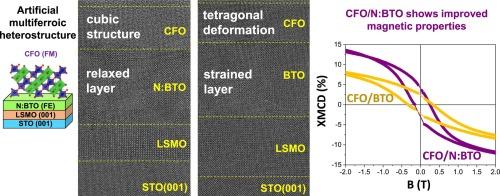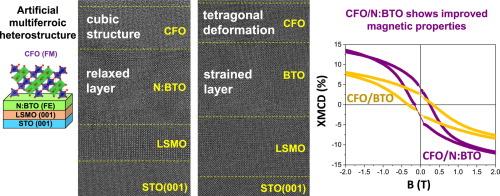利用掺杂诱导的塑性应变弛豫操纵人造多铁体
IF 6.9
2区 材料科学
Q2 CHEMISTRY, PHYSICAL
引用次数: 0
摘要
在这项工作中,我们对在La2/3Sr1/3MnO3/SrTiO3(001)衬底上生长的未掺杂和自氧化n掺杂BaTiO3薄膜上沉积的CoFe2O4层的生长和磁性进行了全面的比较研究,这是一个典型的磁电多铁性体系。采用等离子体辅助分子束外延法生长氧化层。我们发现,即使在1 %的低水平N掺杂,也会引起BaTiO3和CoFe2O4顶层的生长模式和应变松弛的实质性变化,从而增强磁化和降低磁晶各向异性。磁性能是通过广泛的特定元素的磁性x射线二向性测量来确定的,并通过晶体场多重计算来模拟。利用掠入射x射线衍射和高分辨率电子显微镜研究了样品的结构特性。我们的观察结果提供了证据,表明下面的铁电n掺杂BaTiO3层的塑性弛豫影响了顶部CoFe2O4层的磁性能,并且可以作为操纵多铁材料预期性能的额外调谐参数。本文章由计算机程序翻译,如有差异,请以英文原文为准。


Manipulation of artificial multiferroics using doping-induced plastic strain relaxation
In this work, we present a comprehensive and comparative study on the growth and magnetic properties of CoFe2O4 layers deposited on both undoped and self-oxidized N-doped BaTiO3 films grown on La2/3Sr1/3MnO3/SrTiO3 (001) substrates, a prototypical magneto-electric multiferroic system. The oxide layers were grown by plasma-assisted molecular beam epitaxy. We show that N doping, even at a low level of 1 %, induces substantial changes in growth modes and strain relaxation in BaTiO3 and consequently in the CoFe2O4 top layer, which exhibits enhanced magnetization and reduced magnetocrystalline anisotropy. The magnetic properties were determined from extensive element-specific magnetic X-ray dichroic measurements, which were simulated through crystal field multiplet calculations. The structural properties of the samples were investigated using grazing incidence X-ray diffraction and high-resolution electron microscopy. Our observations provide evidence that the plastic relaxation of the underlying ferroelectric N-doped BaTiO3 layer affects the magnetic properties of the top CoFe2O4 layer and can serve as an additional tuning parameter for manipulating the expected properties of multiferroics.
求助全文
通过发布文献求助,成功后即可免费获取论文全文。
去求助
来源期刊

Applied Surface Science
工程技术-材料科学:膜
CiteScore
12.50
自引率
7.50%
发文量
3393
审稿时长
67 days
期刊介绍:
Applied Surface Science covers topics contributing to a better understanding of surfaces, interfaces, nanostructures and their applications. The journal is concerned with scientific research on the atomic and molecular level of material properties determined with specific surface analytical techniques and/or computational methods, as well as the processing of such structures.
 求助内容:
求助内容: 应助结果提醒方式:
应助结果提醒方式:


